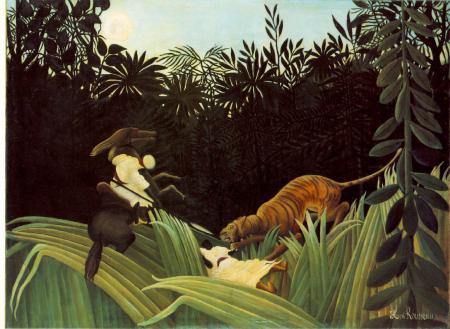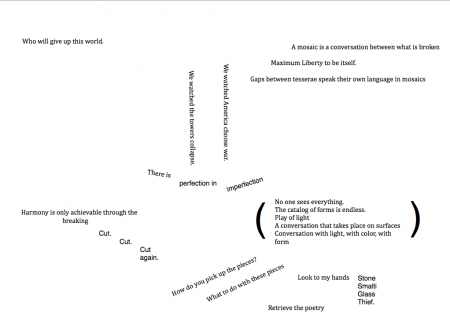Serendip is an independent site partnering with faculty at multiple colleges and universities around the world. Happy exploring!
tflurry's blog

NW Revisited
Although at first glance the chapter naming system in NW, by Zadie Smith, seems almost arbitrary, there is an underlying intent behind the chapter-nomenclature. This paper intends to examine how the Natalie and Leah’s reactions towards their pasts are revealed through the chapter titles within their sections of the book: Visitation and Host.

Self-Reflection
When I first walked into Play in the City, I was a decent high school-level essay writer. Over the course of the semester, I learned more. I picked up more tools, things like ‘lenses’ and ‘the believing game’ for my writing toolbox, and these are tools that I expect to be very useful over the years. I discovered new terms and theories with which to interact with the world around me, different types of play and luck, that may or may not affect my writing in the future, but gives me different ways to think about my experiences: I consider that even more valuable to come away from a class with. In the end, I believe that I have improved in a few ways in my writing over the semester: I think about my essays differently, and in doing so I write them differently: I think about things like lens and how best to frame the point I want to make, what best proves my point or what point best discusses what I want to examine. I recognize, however, that I still have a lot to learn: my essays are not always as focused as they would ideally be, and they often have an overabundance of one punctuation mark or another. I thank this course further for that, because it not only taught me, but gave me an idea where to go next.

The Problem of Practicality
I rather enjoyed Sontag’s essay; her argument was an interesting one, a point of view that I had thought in passing but never considered in depth. That said, I found her somewhat frustrating, simply because while her argument is all well and good, she offers no practical advice for how to put it into action. Particularly among traditionally educated people and in the North American school system, students are taught little else but how to interpret everything they see. It is incredibly rare for me to look at anything and not start automatically dissecting it for ‘deeper meaning’, and on those rare occasions I experience a piece without analyzing it, its purity remains unsullied for the length of time for me to realize what I’ve experienced before I go back to the begin and analyze it then. What seemed to me to be one of the interesting parts of her argument, and the part that she least touched on, is how to incorporate her ideas into practical use. How does one use this ‘vocabulary of form’ she discusses, without making comparisons of some sort? How can one discuss anything without comparisons? And how, among a group of people taught to interpret, taught to make connections that are not inherent to the piece, how can one make comparisons without connections, and through those interpretation?

The Barnes, Revisited
The weekend of November 25th, I visited the Barnes foundation for the first time. While there, I enjoyed the art; travelling from room to room, watching the interplay and conversations between the pieces and the objects, studying how things reflected, contrasted, or contradicted each other. I’m sure Barnes would have approved of my attempt, no matter what he thought of the situations under which I was making it. Next, I sat in front of “Scout Attacked by a Tiger”, by Henri Rousseau, for thirty minutes. This, I think, Barnes would have objected to.


Final Trip Plans
Sorry, I accidently deleted this!
I had intended to go to a poetry slam on Friday, but was unable to, due to a conflict with my performance of Henry IV. Instead, I shall go to the Macy’s Christmas show, not too far away from city hall. I intend to try for original, deep play, rediscovering the light show and Christmas spirit, through one of the methods Walker Percy proposes- seeing the wonder through the lens of the tourism.

A Matter of Context
The information I learnt through the readings, movie and discussion primarily drove home to me how lucky I am to be able to see these art pieces. The paper I wrote about my visit to the Barnes was almost exclusively about my observations on Henri Rousseau’s “Scout Attacked By a Tiger”; the information I learnt about Barnes does not affect what I saw in that painting. However, if I rewrote the paper to focus more on the Foundation, the information I learnt would be used to discuss the differences between how the art was originally shown and how it is shown now, and how those differences might affect my interpretation of the art.

The Attack
What drew me to this painting is primarily the subject matter, and the way the subjects seem to almost glow against the dark background. Two men in white and a ferocious tiger battle desperately deep in some jungle, and there is no way to tell who will win. The piece is “Scout Attacked by a Tiger”, by Henri Rousseau, and it made me think.


Dewey and Roses
Dewey argues that one needs to understand something, one must understand how it relates to the world around it, how it works. I find this an interesting idea; it is, I admit, how I like to think about the world. Nonetheless, I am not sure that it is always the best approach to a topic. I did not understand all the foreign languages Thaddeus Phillips spoke, I did not understand all the international interactions that played into his show, and I have not been out of the country since I was very young, yet I understood his work and enjoyed it immensely. Someone once posed an idea: “You can take a rose, dissect it, discover how it grows, why it flowers, what makes it so red and so sweet smelling. And when you are done, surrounded by shredded petals and stems, ask yourself this: is this still a rose?” While there is a certain amount of depth and interest to be discovered in the connections behind a work, at what point is it better for a viewer to let the connections go?

Improvisation
A small stage in a crowded room, containing a piano, a drum set, and two seats; at the moment, those seats are pushed to the back behind a small brass ensemble. The restaurant is full of happy, idly chatting people enjoying their meals, listening to the jazz music; I’m next. My first jazz performance, and my first performance with vocal improvisation; my nerves had been bad all week, terrible all day. More than once my parents assured me that they would not think less of me if I were not to go, if I were too sick to make it, and how pale you look! Even my teacher had said she’d understand- I can only imagine how frail I must have looked, for them all to worry about my first public improvisation. Far too quickly, the ensemble group before me finished; it was just myself, and three instrumentalists I had never seen before in my life. The only one of them I could see was the pianist, and I was absolutely terrified. The song was Autumn Leaves, and I was to sing it straight once through, before improving it through and then singing it a third time. The music started; there was no going back. The first verse went off without a hitch. So did the second. By the third I started to worry again; next I was to begin scatting. Then the pianist caught my eye. I sang a few notes; not the straight melody, but not too far off. Playing it safe. He took the thread and spun it around, playing it back with a new twist; he was improving as well. Emboldened, I took his idea and ran it a little farther; he took it back, and we played tag with the melody throughout.



